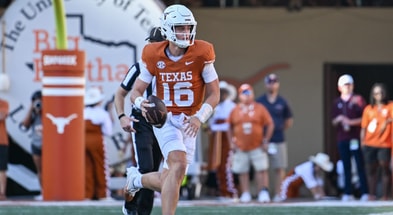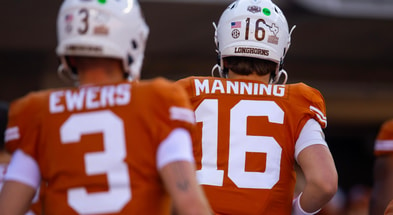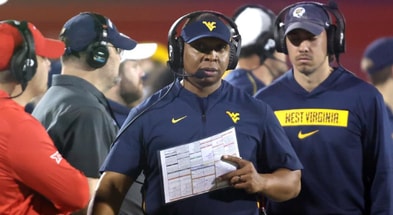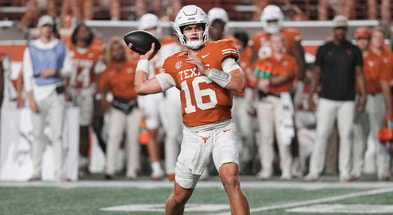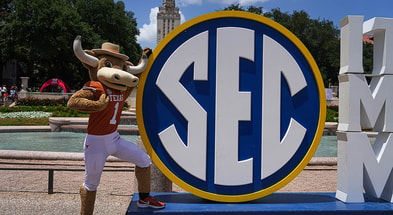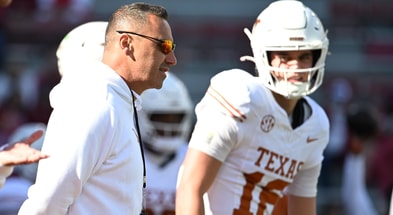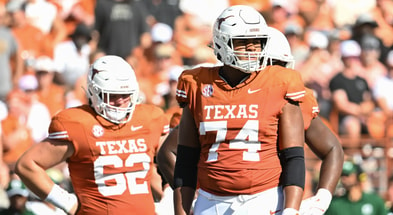Texas stands to greatly benefit from the geographically contiguous nature of the SEC

By Inside Texas intern Lawton Paddock: Texas embarking on its SEC adventures this fall gives fans plenty to be excited about. The prospect of facing more big name schools, gaining a recruiting advantage, or expanding program earnings may come to mind.
[Sign up for Inside Texas and get ONE MONTH for $1!]
However, one favorable aspect of conference realignment that many have yet to consider are the ameliorated road trips on away games. The Big 12 as Texas left it was by no means a geographically contiguous conference, with destinations stretching from Utah to West Virginia and located in multiple regions of the United States. It’s expanded further with teams like Arizona, Colorado, Arizona State and Utah set to join the league on July 1.
All things considered, UT joining a conference that operates in geographic harmony is a luxury that is actually quite rare in the new landscape of college football. It’ll be a great advantage for fans looking to explore new locales in the Longhorns’ new league.
This year, Texas’ conference games away from Darrell K Royal-Texas Memorial Stadium include Oklahoma (neutral site, 195 miles), Vanderbilt (855 miles), Arkansas (526 miles), and Texas A&M (105 miles), for an average one-way trip of 420 miles. For reference, in a year like 2021 where Texas had to play at West Virginia (1397 miles) and Iowa State (960 miles), the average journey for each conference away game was 660 miles each way, which makes for a much more exhausting trip for all involved.
What about 2025 when the Longhorns have to go to Kentucky, Georgia, Florida, and Mississippi State in addition to the Cotton Bowl clash versus the Sooners? Kroger Field in Lexington, Ky. is 1067 miles away from DKR. The Swamp in Gainesville, Fla. is 1008 miles away from the 40 Acres. Sanford Stadium in Athens, Ga. is 985 miles from Austin. Davis Wade Stadium in Starkville, Miss. is 650 miles away. As mentioned, the Cotton Bowl is a 195-mile trip up IH-35, so the 2025 average distance is a manageable 781 miles away. A hike via car, but a quick journey via plane.
The numbers look even better for Texas when measured against new Big 10 schools USC and UCLA, who have to make the trek from Southern California to the Midwest or East Coast every other weekend. USC has an average one-way road trip of 2082 miles this upcoming season, with the longest being to Maryland (2643 miles) and the shortest trip to Nebraska (1505 miles).
Top 10
- 1New
Paul Finebaum
CFB is at very dangerous point
- 2Hot
Bracketology update
No. 1 seeds change in update
- 3Trending
Stolen cars
Carson Beck, Hanna Cavinder cars stolen
- 4
Texas football
Longhorns cancel spring game
- 5
CFP seeding
SEC, Big Ten make hopes clear
Get the On3 Top 10 to your inbox every morning
By clicking "Subscribe to Newsletter", I agree to On3's Privacy Notice, Terms, and use of my personal information described therein.
UCLA ventures as far out as Rutgers (2770 miles) and as close as Washington (1134 miles) in conference play for an average trip of 2001 miles in four games. (The November 23 battle between the Trojans and Bruins was not included in these calculations).
While UCLA and USC faithful aren’t going to drive those journeys, the fans and players will have to take lengthy flights often across time zones if they want to see their beloved programs play.
And if the Longhorns make their conference title game? The journey to Atlanta’s Mercedes-Benz Stadium is just 956 miles away on an easy direct flight. If the Bruins or Trojans break through and make it to the Big 10 Championship? Angelenos would have to trek at least 2000 miles to Indianapolis. At least they have LAX to help mitigate that problem.
[Subscribe to the Inside Texas YouTube channel!]
Clearly, in terms of geographic consistency, Texas improved the condition of their athletic program with the move to the Southeastern Conference, benefiting both players and fans. The move only stands to help Texas grow, with contiguity, finances, recruiting, and fan enjoyment all being bolstered from the realignment.


